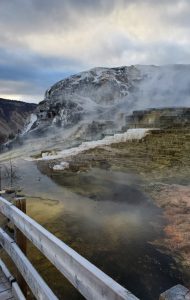This trip has been one of the most fun and one of the most educational trips I have taken during college so far. Not only did I get to go somewhere I’ve never been but I also got to learn about and see a whole bunch of animals. Some species that I knew about and other I had never heard of.
Pika, for example, I had never heard of them but they are an important indicator species in Yellowstone. When we went out and helped our guide with a Pika survey I didn’t know what to expect. We learned that they create haystacks to dry out their food for the winter. They are really intolerant to climate change. So, if the temperature changes more than a few degrees they can die. I didn’t know that there was a species that could be that affected by temperature change. It really brings climate change to the forefront of the discussion of whether or not pika can survive through the next couple decades of temperature change. The speaker on climate change talked a lot about how all over the world would be temperatures would be changing gradually over the next few decades. He mentioned that areas that were already hot and dry and becoming hotter and drier. He also mentioned wet and cold places were starting to become even wetter but also warmer. It doesn’t sound extreme when you think about it in terms of a few degrees warmer on average, but it can have a devastating affect on wildlife and their habitats.
We saw a grizzly bear in the distance on our third day. It was an amazing sight to see but we’re also learned about how this bear’s food sources are becoming for and more threatened. Their main source of calories right before winter is a species of moth. This species is known as the army cutworm moth is being affected by pesticides before they cam even get to Yellowstone to become a food source for the largest carnivore in the park. Farmers are spraying their crops with pesticides, which in turn kills the moths, which then makes it so bears can’t eat enough moths to satisfy their caloric needs for the winter. Another one of their high caloric food sources, the whitebark pine, is going extinct slowly. More and more of them are killed by disease each year. The disease is called blister rust which is a fungal disease that slowly kills the tree. This is another big blow for the grizzlies. It doesn’t stop there, another one if their major food sources the cutthroat trout are being outcompeted by lake trout. You would think that grizzlies could then just switch to eating the invasive species of fish but lake trout are much larger fish and when they are threatened they dive deeper into the water. They have been documented to drown eagles who mistake them for easier prey. The eagles are dragged under the water by the weight of the fish and they can’t pull back up. If all of these prey species that the grizzlies rely on to get energy for the winter go extinct the grizzlies will be severely affected. This shows that not only the mainstream species need to be monitored but all species.
We learned so much about wolves during this trip. We were lucky enough tho see a pack run through the valley on the second day. They are the top predator in Yellowstone. They are also a keystone species in the park. They are intelligent, pack oriented, and incredible hunters. They were unfortunately eradicated from Yellowstone in the mid-1900s. People thought that if they got rid of the predators they would have an unlimited amount of deer and elk and other prey items to hunt. They believed it would be a hunter’s paradise. They succeeded in killing of the wolves but they soon realized the problem of not having a natural predator around to keep prey populations under control. Without wolves Yellowstone’s population of elk ran rampant. The population eventually exceeded the park’s carrying capacity and disease and winter kills become increasingly common. The elk aslo overgrazed the park which caused problems on river banks and in the valleys. This is what is called a trophic cascade. When you remove an important species everything down the food chain gets disrupted. The speaker from the wolf project talked about the reintroduction and how they picked which wolves to use. Once wolves were back in Yellowstone the elk population went down to a reasonable number and the vegetation started to regrow.
We learned all of this and more. This was an incredible opportunity and a wonderfully spent school week. To be able to see all of these animals in person was wonderful. I would definitely recommend taking this class if you want to learn more about the ecosystem and all of the interactions between the species in Yellowstone.
